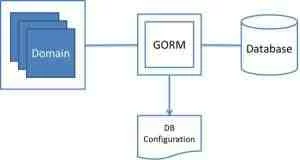Grails – GORM Tutorial
Grails is known as domain driven language that means we can build application using bottom to top approach which is more nearer to object oriented programming. GORM (Grail Object Relational Mapping) uses intern Hibernate to map the domain with table which gives life to Domain modeling. If we combined everything just only based on domain we could build the whole web application. Scaffolding can bring domain design directly to visible state to business users with extra involvement

But keep in mind Grails is an agile development framework. That means we build application quickly, deploy and run in one shot and make changes any layer without impacting other parts such UI, domain modeling, service class etc.
Create Domain class
Grails treats the domain classes as the most important part of the application. This is root of application which helps to visualizes overall application. You could treat it as an entity object which tightly coupled with database table.
Let’s start with creating a simple domain class name User with fields’ username and userpassword
1 2 3 | D:\grails_book\firstapp>grails create-domain-class com.UserManagement.UserThis creates a new class file in /firstapp /domain/com/UserManagement/User.groovy(A corresponding unit test in /test/unit/com/grailsinaction/UserTests.groovy). |
1 2 3 4 5 6 7 8 9 | package firstapp.domain.com.UserManagementclass User { long userid String username String password static constraints = { username(blank: false) }} |
Note: We no need to worry about setter and getter as Grails/Groovy dynamically generate.
By default, all the fields in a domain class are persisted to the database. The User class contains two fields’ username and password which will map to table User with column name username and password. GORM provide following dynamic methods to access database without exploring the PL/SQL directly.
- User.save() saves the data to the User table in the database.
- User.delete() deletes the data from the User table.
- User.list() returns a list of Users.
- User.get() returns a single User
Relationship
Grails gives flexibility to make various combination of mapping such as one-to-one, one-to-many, many –to-many.
It uses belongsTo for unidirectional and hasMany and direct reference for bidirectional. hasMany also uses for many relationship. In subsequent topic we will discuss in detail uses of these properties.
One-to-one relationships
One-to-one relationships could be unidirectional or bidirectional with single valued reference. For example User has single address and each address belongs to only one user. Following figure illustrates that a one-to-one relationship between user and his address.
Figure Assigning one-to-one on entities

For defining relationship between user and address first we will create domain class as follows
We will start creating
1 2 | D:\grails_book\firstapp>grails create-domain-class com.onetoone.domain.BookD:\grails_book\firstapp>grails create-domain-class com.onetoone.domain.Author |
In below example belongsTo field inform GORM that Book has a relationship to Author and eligible for cascade, so if any Author deleted, the matching Book will also be deleted. We can define One-to-one relationship unidirectional or bidirectional by defining belongsTo on Address object and adding Address reference on User (owner) object.
01 02 03 04 05 06 07 08 09 10 11 12 13 14 15 | package com.onetoone.domainclass Book { Long id String bookName String bookDesc static belongsTo=Author //Book belong to Authorstatic constraints = { //For validtion }String toString(){ "Book name:${bookName}" }} |
One-to-many Relationship
One-to-many relationship occurs when one object has a multivalued relationship with another object.
For example one-to-many relationship exists between employee and department. Below figure depicts that a department can have many employees, but that each individual employee can work for only one department
Figure : Assigning one-to-many on entities

Grails introduces hasMany and belongsTo properties to establish one-to-many relationship.
For e.g. hasMany need to define on Department domain and belongsTo need to define on Employee domain class as follows:
01 02 03 04 05 06 07 08 09 10 11 12 13 14 15 16 17 18 19 20 21 22 23 24 25 26 27 | package com.onetomany.domainclass Department { long id String departname String departmentLOB static hasMany=[employees:Employee]static constraints = { }}package com.onetomany.domainclass Employee { long id String employeename String emailid String phonestatic belongsTo=Departmentstatic constraints = { employeename(blank: false) } static mapping = { sort employeename:"desc"// "desc" for descending // "asc" for ascending }} |
After establishing one-to-many relationship between Department and Employee, Grails automatically adds two new methods to your User class: Department.addToEmployees () and Department.removeFromEmployees () to add the reference objects.
Please click here to download the code
Conclusion
Domain is the heart of Grail based development which map domain as entity to database table without configuration or annotation (used on JPA based framework).






